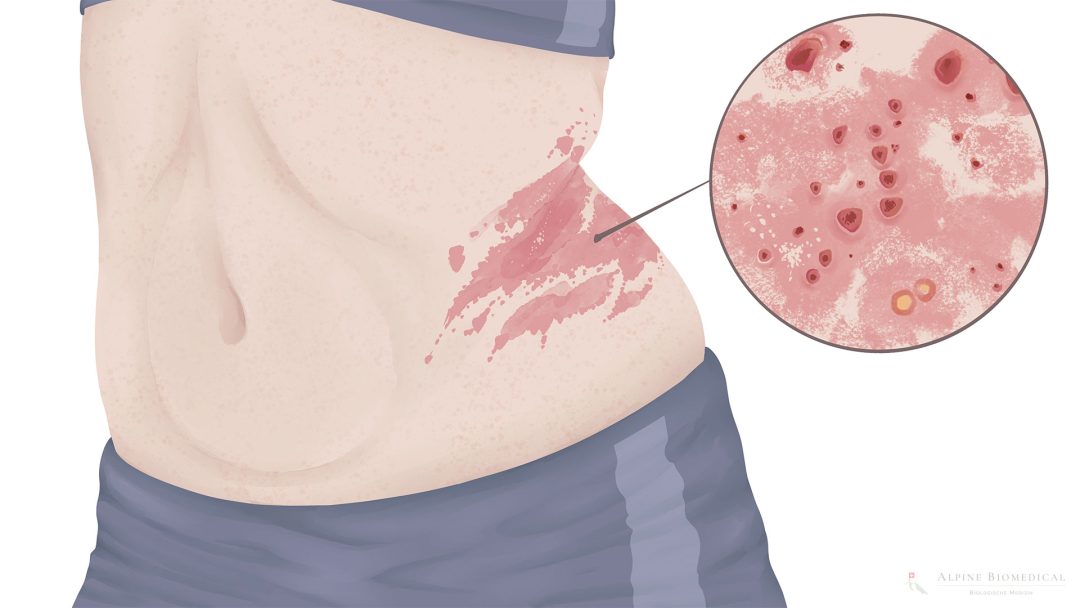Shingles

Shingles, also known as herpes zoster, is a painful skin disease caused by the varicella zoster virus.
Shingles is always a reactivation of the virus in the body. Consequently, shingles must have been preceded by an initial case of chickenpox (varicella).
Various causes such as stressful situations, influenza, a weakened immune system, but also the intake of medication can lead to the reactivation of the varicella zoster virus.
Symptoms
Shingles manifests itself as a belt- or strip-shaped rash with blisters, itching and burning or pulling nerve pain. The blisters burst after a few days and become crusty. Shingles can occur in any part of the body, but is often localized in the chest or abdomen. In addition to a skin rash, fever and general malaise may also occur.
Causes
The varicella zoster viruses remain dormant in the ganglia (collection of nerve cell bodies) after a chickenpox infection and can multiply from there. This process is known as reactivation. The viruses travel via the nerve cords to the skin and form the typical symptoms of shingles. What triggers reactivation is not fully understood. The central point in the outbreak is the immune system, which can be weakened by various stimuli.
The following causes for reactivation and thus an outbreak of shingles are being discussed:
- Excessive stress
- Colds and flu
- Excessive UV radiation (intensive sunbathing)
- Weakened immune system
- Exposure to toxins
- Chronic intestinal diseases
- Various medications
- Increased oxidative stress
- Deficiencies in micronutrients
Treatment of Shingles
Early treatment is crucial to prevent complications of shingles. Treatment primarily involves rest and a light plant-based diet. In more severe cases, antiviral therapy and the use of painkillers may be considered. Zinc-containing creams can be helpful against itching.
Holistic medical approaches include targeted measures to eliminate toxic metals, reduce environmental toxins and carry out intestinal cleansing. Intestinal cleansing is an essential aspect, as around 80% of the immune system is located in the intestines.
A body that lacks vitamins, minerals and trace elements, but is also exposed to increased oxidative stress, has difficulty maintaining a healthy immune system. Consequently, micronutrients and antioxidants should be supplied after a full individual diagnosis.
A targeted supply of lysine can also curb the spread of viruses.
Is Shingles contagious?
Shingles is contagious for people who have never had chickenpox. They can develop a chickenpox infection (not shingles) if they are infected and should therefore be careful.
Infection occurs via the small blisters. When these burst, a fluid rich in varicella zoster viruses is released. Infection can occur through contact (smear infection).
A person with an outbreak of shingles is no longer contagious once the burst blisters have completely crusted over and the skin is healing.
Is Shingles dangerous?
Shingles can pose a health risk and should be treated by an experienced doctor. The following complications can be dangerous:
- Destruction of the nerve tissue with the development of permanent nerve pain (post-zoster neuralgia)
- Permanent damage to the skin areas
- Spread to the blood vessels and other organs
- Visual and hearing disorders when it spreads to the eye and ear
Med. pract. Dana Hreus M.A.
In the case of shingles, it is important to start treatment early in order to avoid dangerous complications. Both the symptoms and the causes should be taken into account during treatment.

Further information
The information listed contains relevant topics and serves to improve understanding.